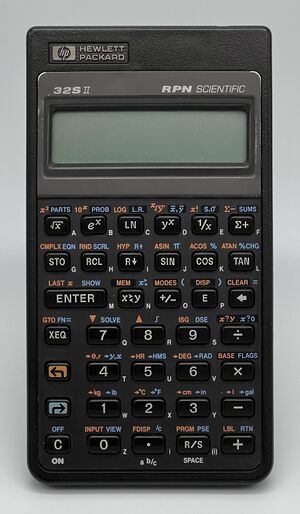HP 32S
 | |
| Predecessor | HP 15C |
|---|---|
| Successor | HP 32SII |
| Programming | |
| Other | |
| Power supply | 3x LR44/AG13 |
| Weight | 121g |
The HP 32S and HP 32SII are a series of scientific calculators sold by HP from the late 1980s to early 2000s.
 | |
| Predecessor | HP 32S |
|---|---|
| Successor | HP 33s |
| Calculator | |
| Display type | LCD |
| Programming | |
| Other | |
| Power supply | 3x LR44/AG13 |
| Weight | 127g |
HP 32S[edit | edit source]
Code named "Leonardo", HP 32S was introduced on 1st June 1988 and discontinued by January 1991.
It was a relatively short-lived mid-range calculator that saw two revisions, the difference being an improved 12 digits 5x7 dot matrix LCD, with larger character size. Originally retailing for $70, there was also an anniversary edition for $50 for shareholders and employees only, the difference being largely cosmetic (with a commemorative plaque on the case).
The HP 32S was powered by a silicon-on-sapphire Saturn processor code named "Sacajawea" manufactured by NEC of Japan, with 512bytes built in RAM and 16KB built in ROM, clocked at 640kHz, shared with other mid-ranged pioneers (HP-14B, HP-22S)
The HP 32S sports a single shift key and thus most of its functions are driven via menus. Only single character alphabetical labels and variable registers are allowed. All instructions can be displayed (instead of their keycodes) and merged (e.g. RCL+ is considered one instruction), and error messages are verbose, significantly improving ease-of-use. However, with only 384 bytes are available, and as each intruction and integer from 0-99 uses 1.5 bytes whereas all other numbers use 9.5bytes, programming complexity is extremely limited.
It also featured a RPN solver, capable of evaluating and finding zero of functions (given as programs) numerically, given initial assumptions.
Notably, HP 32S introduced built-in support for complex numbers in the form of unified stack, with CMPLX prepending operations resulting in the complex variant of each operation, using two stack levels to represent one complex value (arithmetic only in X+iY rectangular form, although conversion to polar form is provided), thus reducing the four level real stack to 2 levels. This differs from HP 15C as there is no explicit complex mode (and normal operations resulting in complex result would still rasie errors) as well as the HP 41C (and more primitive Pioneers like the HP-20S) as it does not rely upon user programs to handle complex operations, thus eating into precious programming space. Somewhat unintuitively, the imaginary part is entered before the real part.
HP 32SII[edit | edit source]
Code named "Nardo", HP 32SII is considered a further cost-reduced version of HP 32S. It was introduced on the 1st March 1991, and discontinued by September 2002 (until NEC was unable to continue manufacture of Saturn architecture chip).
Instead of the elaborate silicon-on-sapphire exposed-die chip held down by plastic, it switched to a more conventional looking plastic wrapped chip design. It is believed the architecture remained the same otherwise. All HP32SII had the later variant LCD as standard.
The 32SII replaced the Up and Down keys on HP32 with Left and Right shifts respectively, bringing much of the menu driven functions to top level, giving it the cluttered keypad look. Two revisions of HP32SII exists with different color scheme. Before 1999 HP 32SII had standard pioneer brown plastic with brown bezel and yellow-blue shifted legends (as seen on the manual). After 1999 this was changed to a white painted bezel (like later HP 17BII) with green-blue shifted legends.
Notably, the HP 32SII added a new "EQN" or equation environment to the machine which supports (and only allows) algebraic logic entry of formulas, with support for bracketed expressions and equivalence, much like that present on the HP 17B series. Solver can be invoked by opening the Equation menu and selecting the desired equation. EQN can also be programmed and Flag 10 can be set to disable EQN validation, using it to display messages instead. However as the memory was not expanded, it suffers the same problems as its predecessor if not more.
The solver can still be used on RPN programs.



